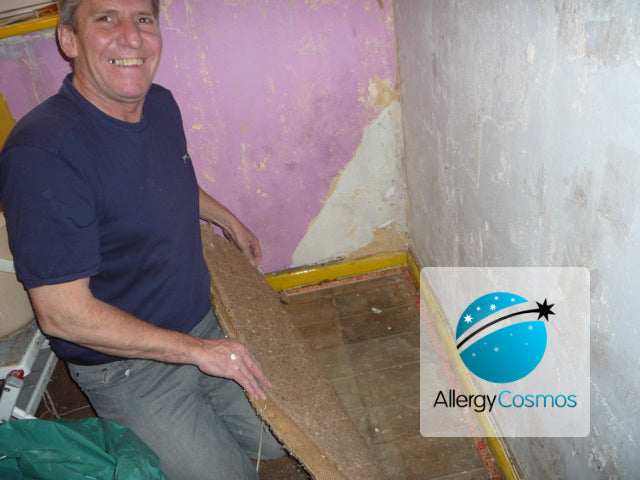I am having the 25-year old carpet in my home office removed and replaced with hardwood floors to improve allergy symptoms. This is a refurbishment job that is well overdue. I discussed the replacement options with Tony, who is doing the work and knows about floors, and we discussed a number of options – namely:
- Natural hardwood
- Laminate
- Tiles
- Stone
- Vinyl
- Lino
- Cork
Or the cheapest option - varnishing the floorboards of the room, once these are revealed and if they are in good condition. To be fair, some of the above options are not really practical for a small home office but I’ve included them just to give you a feel for the choices available. What I’m not doing is going for a new carpet. Here is why. From an Allergy Cosmos point of view, carpet is the unhealthiest floor covering you can have. It contains 100 times more allergens than a hard floor, with one square metre of carpet typically trapping 67 grams (about two ounces of dust). Carpet is a reservoir for the following allergens and other troublesome substances:
- Pet dander
- House dust mite
- Bacteria
- Mould spores
- Dirt from outside brought in on shoes, which will include pollen
Carpet is warm and moist (especially if a spill has not been properly cleaned up) and thus an ideal breeding ground for the house dust mite that feeds off the dust present there. The fibres of a carpet attract dust and while there is a school of thought that says carpet is good because it traps allergens and stops them being airborne, it is in fact all too easy to stir up the dust and other noxious stuff as you tread across the carpet. And what about toddlers who spend a lot of time crawling on the floor – they are directly exposed to the allergens that are present in a carpet.
However, although hard floors are growing in popularity, wall-to-wall carpet is still present throughout many homes. If you are stuck with your carpet – or want to keep it – but have an allergy, you can have an action plan to keep it relatively allergen-free:
- Vacuum – not occasionally but at least once or twice a week (daily, if you can find the time).
- Use a good quality allergy vacuum cleaner that is leakage free. Consider upgrading to a machine fitted with a high-efficiency particulate air (HEPA) filter, which will trap a high proportion of allergens.
- Many vacuum cleaners leak and disperse dust all over your room instead of trapping them in the bag. If it’s not leakage free, replace it.
- Vacuuming, on its own, is not enough to keep the carpet clean. Regular washing, dry cleaning and stem cleaning are essential.
Carpet does have some advantages. It is relatively cheap, provides good insulation against sound and heat and it is comfortable (many people just like the feel of it under their feet). So you may decide to buy a new carpet instead of investing in a hard floor. People with allergies might want to consider the following guidelines:
- Short, tightly-woven pile traps less allergen that long loose pile.
- Wool and natural fibres are better than synthetics, except that nylon is said to repel allergen deposit.
- Rugs with hard flooring are a good compromise – a cotton-based rug can be washed regularly. Coir, sisalseagrassss are other good natural rug options.
- New carpet often contains Volatile Organic Compounds (VOCs) including formaldehyde, which can cause allergy symptoms and Multiple Chemical Sensitivity (they are responsible for the ‘new carpet’ smell that’s often very evident in a new or refurbished office). The VOCs can ‘outgas’ for a number of weeks or even months, so it is advisable to ‘air’ the carpet before laying it down, if at all possible.
- It is not just the carpet which may cause problems. A foam backing may emit formaldehyde so it is better to go for a hessian, felt, or jute (all natural) backing. Glues used to fix the carpet to the floor may also be a source of VOCs so mechanical fixing is preferable.
- There are anti-allergy carpets, which are coated with antibacterial substances. House dust mite needs bacteria to process skin flakes before they can feed on them. Therefore, killing bacteria will reduce house dust mite levels but it is not known how good an anti-allergy carpet is at reducing allergy symptoms.
However good your choice and carpet care is, in reality, it is very hard to keep allergen levels in a carpet down and you will be living with a constant source of trigger for your condition (especially if the carpet is in the bedroom). So why not follow the advice of the Asthma and Allergy Foundation of America – if you have a severe allergy, replace your carpet with hard flooring? By the way, in case you're still having trouble making up your mind whether or not to ditch the carpet, Tony tells me he found a big family of 'carpet bugs' lurking under mine when he ripped it up. That convinced me that I'd done the right thing!




